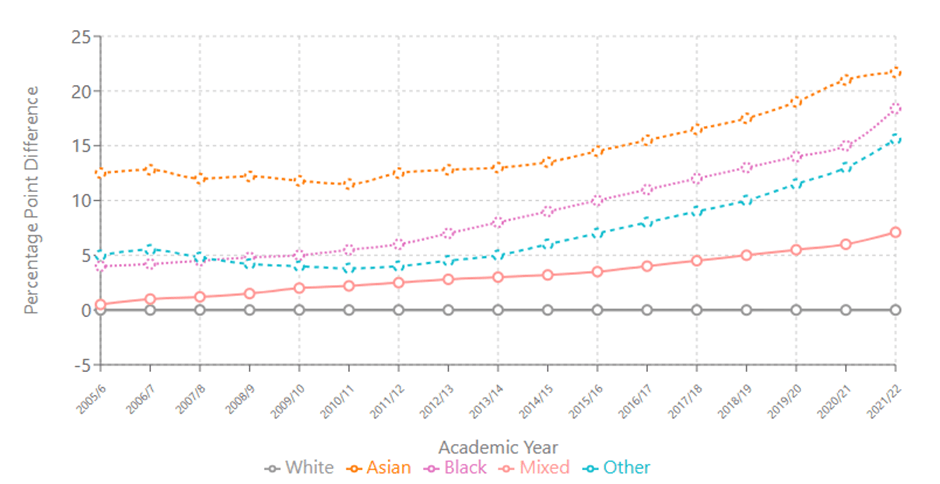- Amira Asantewa is Director of Programmes, Grit Breakthrough Programmes
- Reuel Blair is Lead Diversity Programmes Coordinator at the Centre for Student and Community Engagement, Nottingham Trent University
Progress on the Black-white degree awarding gap has gone into reverse. Figures published by Higher Education Student Data (HESA) in autumn 2024 show that in 2022/23 the difference in the percentage of Black students and white students getting a first- or upper-second-class degree went up to 21.4 percentage points (pps) – from 19pps in 2021/22 and 17.6pps in 2020/21.
Across the sector, institutions are responding. Access and Participation Plans have been signed off. Work towards achieving Race Equality Charter marks is underway. Faculties and departments are decolonising curricula, diversifying assessment modes, tackling the lack of Black representation in the staff body and the postgraduate community.
While there are debates about the way the sector analyses and addresses the awarding gap, what we do know is there is, as yet, little to say about what works in UK universities. However, evidence from our work with students of Black Heritage that suggests social capital is key.
Black leaders
It was back in 2019 that Nottingham Trent University and Grit Breakthrough Programmes co-designed with students the Black Leadership Programme (BLP) – a mix of community-building activities, mentoring, inspirational speakers and work with both employers and global institutions. Centrepiece workshops are delivered by Grit: breakthrough programmes.
Six years on and an independent TASO-funded evaluation found strong statistical evidence of impact on final year grades and that these higher grades were likely to have been caused, not by increased academic engagement, but instead by increased motivation, social capital and sense of belonging.
This reinforced the findings of the independent evaluation of Grit’s Black Leaders and Students of Colour programme across seven universities, which suggested that students were able to apply skills and confidence from having expanded networks and engagement in new experiences, to their academic lives. And the students tell us what this looks like.
Spaces for Black students
Students talk about the importance of access to Black spaces. This space, this community, is a place where Black students are not, as Anike from Liverpool John Moores University puts it, ‘self-censoring to make myself palatable to white people.’ Instead, it is where ‘I can get into the conversations I always wanted to have, feel free to talk about what’s important to me.’
Research describes how Black-affirming campus spaces are vital for Black student academic success and supporting Black student inclusion and well-being. Kwaku from Nottingham Trent University describes the value of ‘a space where there isn’t the weight of always being different. I want a space to connect with people, people who I can talk to about how I am feeling, what I am going though, and who I know would understand.’
So social capital is also about belonging. Zelena from Bath Spa University describes wanting ‘to belong to a community of people we can all turn to, to draw strength from, to look up to and connect with.’
Identity and representation
It is about identity. Students tell us about the importance of ‘realising the value of my own upbringing, my heritage, my culture… that it is not something to be left behind or discarded… I want to explore and appreciate who I am and what I am.’ As Gemma from the University of Greenwich says, it’s about ‘finally claiming my identity. Becoming proud of being Black.’ University is a time for building a new independent life, figuring out who you really are and how your evolving identity fits in this new space. And there is a strong correlation between identities and deeper approaches to learning.
It is about representation, both in the messaging about opportunities and in the ability of those delivering them to relate to the racial identity and cultural backgrounds of the students. Or, as Kane from Nottingham Trent University says, ‘it’s about how we have the right to be noticed, feel heard, to see that my voice, my opinion matters.’
And social capital is also about wanting to make a difference, making a contribution. Afreya from the University of Manchester describes ‘helping other people who are feeling the same as I was. Going out of my way to be visible, showing how anyone just like me, can be successful.’
Students are very clear about social capital: ‘I made friends from the programme. I’ve joined societies… I’ve been a course rep and a Student Ambassador… I’ve been part of a project supporting young Black learners in schools in the city…’
They are very clear about its value: ‘It gave me strength… I’ve been relentless in seizing every opportunity available… I work more efficiently… harder and smarter… I feel that the university has an interest in nurturing Black talent and my growth and development.’
So, alongside all the institutional plans, strategies and initiatives, there also have to be the spaces, places and relationships for Black students to be their full, authentic, very best selves and, just like their white peers, grow the social capital to thrive and succeed in their time at university and beyond.
On 5th June at Nottingham Trent University, Grit Unleashed will take a deep dive into the university experience for Black students and Students of Colour across the UK in a day co-designed and co-delivered by student participants. For more details email [email protected]





